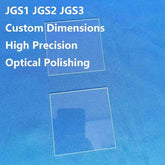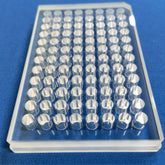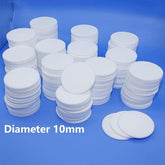Optimizing Quartz Plate Manufacturing Processes for Improved Durability Performance
Quartz plates are a high-performance material that is used extensively across a range of industries including semiconductors, optics, photovoltaics and chemical engineering. Its excellent properties, including high temperature and corrosion resistance, low coefficient of expansion and other characteristics, make it an essential component for many high-precision devices. In practical applications, however, the durability of quartz plates directly affects the stability and service life of the equipment. This article will conduct a detailed analysis of the methods to enhance the durability of quartz plates from aspects such as material selection, processing technology, surface treatment, and quality control.
1. Material selection
The durability of quartz plates is contingent on the selection of their raw materials. The following points should also be noted when selecting materials.
(1) Purity
The purity of quartz plates directly impacts their ability to withstand high temperatures and corrosion. High-purity quartz, with an SiO2 content of over 99.99%, has been shown to effectively reduce the impact of impurities on material performance, thereby enhancing durability.
(2) Homogeneity
The uniformity of the material is crucial in ensuring the stability of quartz plates in high-temperature environments. Defects in materials such as bubbles and cracks present a significant challenge, as they can significantly reduce the mechanical strength and thermal stability of quartz plates, potentially leading to cracking or deformation.

2. Optimization of processing technology
The durability of quartz plates is significantly influenced by their processing technology. The following are several key methods for optimizing processing techniques.
(1) Cutting technique
The cutting of quartz plates should be carried out using high-precision equipment, such as laser or diamond cutting, in order to reduce roughness and micro-cracks in the cutting surface. During the cutting process, it is essential to maintain precise control over the cutting speed and pressure to avoid any potential damage to the material caused by mechanical stress.
(2) Heat treatment
During the quartz plate processing procedure, internal stress is generated, which must then be mitigated through the implementation of an annealing treatment. It is essential to optimize the annealing temperature and time in accordance with the dimensions and intended application of the quartz plate to ensure the complete release of internal stress in the material.

3. Surface treatment
The surface treatment of quartz plates is a key method of enhancing their durability. Through surface treatment, the mechanical properties, chemical stability and optical performance of quartz plates can be enhanced. The following are some of the most common surface treatment methods.
(1) Polished finish
Polishing quartz plates has been shown to reduce surface roughness and stress concentration points, enhancing their mechanical strength and corrosion resistance.
(2) Coating technology
Coating quartz plates with a protective film, such as a silica coating or a metal oxide coating, is an effective method of enhancing their high-temperature resistance and corrosion resistance. The coating must be uniform and firmly attached to the substrate to prevent peeling.
4. Quality control
Strict quality control measures are paramount to ensuring the durability of quartz plates. The following are the main links of quality control.
(1) Raw material inspection
Prior to the storage of raw materials, it is imperative that strict chemical composition analysis and defect detection is carried out to ensure that the materials meet the requirements of the design specifications.
(2) Process monitoring
During the processing, it is imperative to monitor key process parameters such as cutting speed, annealing temperature, and forming pressure in real time to ensure the stability and consistency of the process.

(3) Inspection of the finished products
Quartz products must undergo comprehensive performance testing to ensure dimensional accuracy, surface quality, mechanical strength and thermal stability. In order to ensure optimal performance, quartz plates utilized in high-precision applications should undergo rigorous optical performance testing.
5. Application environment adaptability
The durability of quartz plates is also closely related to their application environment. In practical applications, the design and processing of quartz plates should be optimized in a targeted manner based on specific application scenarios.
(1) High-temperature environment
In the context of high-temperature applications, quartz plates must exhibit enhanced thermal stability and a low coefficient of thermal expansion. Its performance at high temperatures can be enhanced through optimization of the material formula and processing technology.
(2) Corrosive environment
In corrosive environments, the surface treatment of quartz plates assumes particular importance. The enhancement of its corrosion resistance can be achieved through the implementation of coating technology or chemical passivation treatment.

(3) Mechanical load
In applications subjected to mechanical loading, quartz plates are required to exhibit higher levels of mechanical strength. The compressive and bending resistance of the material can be enhanced by increasing the wall thickness or optimizing the structural design.
6. Conclusion
Enhancing the durability of quartz plates constitutes a systematic endeavor that encompasses multiple critical factors, including material selection, processing techniques, surface treatments, quality control measures, and compatibility with operational environments. Through the optimization of these components, the mechanical strength, thermal stability, and chemical resistance of quartz plates can be substantially improved, thereby extending service life and ensuring suitability for use in high-precision equipment.






